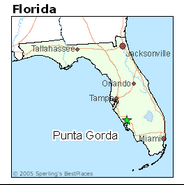1956 Punta Gorda outbreak

1956 Punta Gorda outbreak: In the spring of 1956, at least 150 cases of an illness diagnosed as Epidemic Neuromyasthenia occurred in Punta Gorda, Florida, a small community of approximately 3000 residents on Charlotte Harbor Bay on the state's southwest coast.[1] The pattern of spread was consistent with a person-to-person transmission of an infectious agent.
Two approaches were applied to determine the nature and incidence of the illness. One consisted of a detailed examination, history and laboratory results of twenty one of the cases reported to physicians. The second approach consisted of a house-to-house survey to identify cases not reported because of a more mild illness presentation.[1]
A mass conversion reaction was ruled out as "little apprehension about the medical problem appeared to exist among the general population."[1]
Symptoms[edit | edit source]

Symptoms differed slightly from patient-to-patient. They included but were not limited to: fatigue, headache, nuchal (nape or back of the neck) pain, muscle aches and pain, paresthesia, paresis, fever, nausea and vomiting, diarrhea, loss of appetite, difficulty in swallowing, cognitive and emotional changes, such as confusion, memory impairments, especially in short term memory, difficulty with math calculations, depression, episodic crying, "tension," nightmares, hyperventilation, visual disturbances, such as blurred and /or double vision, dizziness, and unsteadiness.[1]
Findings[edit | edit source]
Clinical laboratory findings of serum, cerebrospinal fluid, stool, throat swabs, tissue samples, and EKG were interpreted to be unremarkable or within normal range. Many potential causes for the outbreak were investigated, such as, food, milk, water, personal care products, and mosquitoes, but none were found.[1]
Epidemiology[edit | edit source]
- ~150 cases (6.1% of the community population) were identified[1]
- the onset of cases occurred from mid-March 1956 until June 1, 1956[1]
- no children under 12 yrs became ill[1]
- the incidence and severity was higher in females (8.2% of the female population versus 4.0% of the male)[1][2]
- 42% of medical and hospital staff were affected which is disproportionately higher than the general population[1]
- the incubation period was less than one week, probably five to six days,[2]
- the duration lasted from one day to more than six months[1][2]
Course & prognosis[edit | edit source]
The illness course was prolonged and relapsing, often requiring being bedridden, sometimes requiring hospitalization.[1] On followup, patients often had periods of improvement with exacerbations of symptoms, often after increased physical exertion or occurring during the premenstrual period.[1]
See also[edit | edit source]
- Epidemic myalgic encephalomyelitis
- List of myalgic encephalomyelitis and chronic fatigue syndrome outbreaks
Learn more[edit | edit source]
- In the Bughouse, The New Yorker by Berton Roueché.
References[edit | edit source]
- ↑ 1.00 1.01 1.02 1.03 1.04 1.05 1.06 1.07 1.08 1.09 1.10 1.11 1.12 1.13 Poskanzer, David C.; Henderson, Donald A.; Kunkle, E. Charles; Kalter, Seymour S.; Clement, Walter B.; Bond, James O. (1957), "Epidemic Neuromyasthenia — An Outbreak in Punta Gorda, Florida", New England Journal of Medicine (257): 356-364, doi:10.1056/NEJM195708222570802, PMID 13464939
- ↑ 2.0 2.1 2.2 Acheson, E.D. (1959), "The Clinical Syndrome Variously Called Benign Myalgic Encephalomyelitis, Iceland Disease and Epidemic Neuromyasthenia" (PDF), American Journal of Medicine, 26 (4): 569–595

